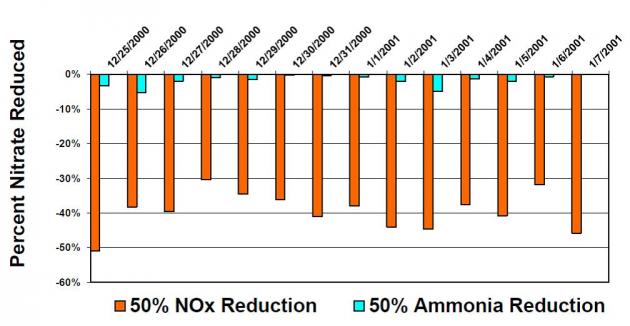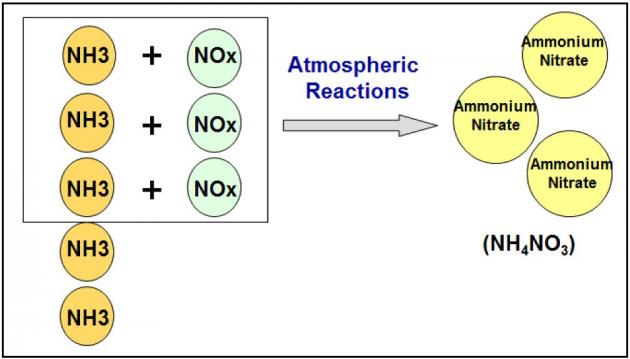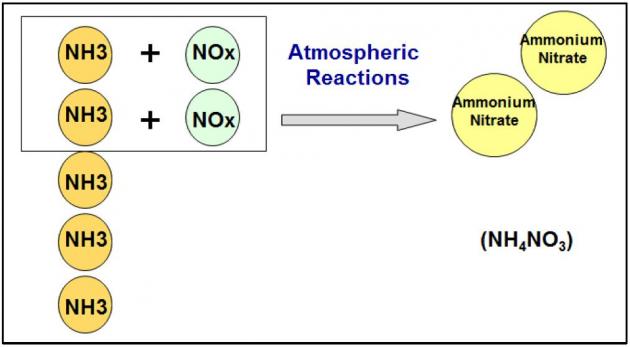Recently there has been increased interest in regulating ammonia emissions to reduce PM2.5 (“fine” particles with an aerodynamic diameter less than 2.5 micrometers) concentrations. However, understanding the quantity of and interactions between ammonia and nitrogen oxide (NOx) is necessary in determining whether controlling ammonia is an effective strategy for reducing PM2.5 in a particular region. Research from the California Regional Particulate Air Quality Study and other studies has demonstrated the relative abundance of ammonia in comparison to the limited concentrations of the other key precursor, nitric acid formed by NOx emissions. As a result, NOx acts as the primary limiting precursor for the formation of secondary ammonium nitrate in the San Joaquin Valley (SJV). Modeling based on data from these studies also found that controlling NOx was the most effective strategy to reduce ammonium nitrate particulate in the SJV and controlling ammonia had little effect on PM2.5 concentrations.
In summary and as explained in the San Joaquin Valley Air Pollution Control District 2012 PM2.5 Plan, the best scientific information available indicates that controlling NOx emissions is the most effective strategy to reduce secondary ammonium nitrate in the SJV. While it has been demonstrated that controlling ammonia will not significantly reduce PM2.5 concentrations in the SJV, the District has adopted stringent regulations that have significantly reduced ammonia emissions.
Purpose
The San Joaquin Valley is primarily a rural region with large areas dedicated to agriculture. Recently there has been increased interest in regulating ammonia emissions from agricultural operations and other sources as a means to reduce PM2.5 concentrations. However, understanding the quantity and interactions between ammonia and NOx are necessary in determining whether controlling ammonia emissions is an effective strategy for reducing secondary PM2.5 formation in a particular geographic region.

The United States Environmental Protection Agency (U.S. EPA) periodically reviews and establishes health-based air quality standards (often referred to as National Ambient Air Quality Standards, or NAAQS) for ozone, particulate matter (PM), and other pollutants. Although the air quality in California’s San Joaquin Valley has been steadily improving, the region is currently classified as “serious” non-attainment for the 1997 and 2006 federal ambient air quality standards for PM2.5. The periods for which measured PM2.5 concentrations drive nonattainment of these standards occur primarily in the winter months and air quality research in the San Joaquin Valley has identified ammonium nitrate as the predominant contributor to secondary PM2.5 in the region. Ammonium nitrate particulate is formed through chemical reactions between ammonia in the air and NOx emissions produced by mobile and stationary combustion sources. As shown in Figure 1 above, ammonium nitrate is commonly the largest contributor to PM2.5 mass during the winter in the San Joaquin Valley.
What did we do?
 Atmospheric modeling has demonstrated that controlling NOx is the most effective strategy to reduce ammonium nitrate concentrations in the San Joaquin Valley and controlling ammonia has little effect on these concentrations. The California Air Resources Board conducted multiple modeling runs to simulate the formation of PM2.5 in the San Joaquin Valley and compare the effect of reducing various pollutants on PM2.5 concentrations. As seen in Figure 2, U.S. EPA’s Community Multi-scale Air Quality (CMAQ) indicated that reducing NOx by 50% reduced nitrate concentrations by 30% to 50% reductions, while reducing ammonia by 50% resulted in less than 5% reductions in nitrate concentrations. Similarly, the UCD/CIT photochemical transport model indicated that for the conditions on January 4-6, 1996 in the San Joaquin Valley, controlling NOx emissions is far more effective for reducing nitrate concentrations than controlling ammonia.
Atmospheric modeling has demonstrated that controlling NOx is the most effective strategy to reduce ammonium nitrate concentrations in the San Joaquin Valley and controlling ammonia has little effect on these concentrations. The California Air Resources Board conducted multiple modeling runs to simulate the formation of PM2.5 in the San Joaquin Valley and compare the effect of reducing various pollutants on PM2.5 concentrations. As seen in Figure 2, U.S. EPA’s Community Multi-scale Air Quality (CMAQ) indicated that reducing NOx by 50% reduced nitrate concentrations by 30% to 50% reductions, while reducing ammonia by 50% resulted in less than 5% reductions in nitrate concentrations. Similarly, the UCD/CIT photochemical transport model indicated that for the conditions on January 4-6, 1996 in the San Joaquin Valley, controlling NOx emissions is far more effective for reducing nitrate concentrations than controlling ammonia.
What have we learned?
 Ammonium nitrate particulate is limited by NOx in the San Joaquin Valley
Ammonium nitrate particulate is limited by NOx in the San Joaquin Valley
Extensive research conducted through the California Regional Particulate Air Quality Study (CRPAQS) and other studies has demonstrated the relative abundance of ammonia in comparison to the limited concentrations of the other key precursor, nitric acid formed by NOx emissions in the San Joaquin Valley. As a result, NOx (via nitric acid) acts as the primary limiting precursor for the formation of secondary ammonium nitrate. (See Figures 3 and 4)
Future Plans
 As explained in detail in the San Joaquin Valley Air Pollution Control District 2012 PM2.5 Plan, the best scientific information available indicates that controlling NOx emissions is the most effective strategy to reduce secondary ammonium nitrate in the San Joaquin Valley. While ammonia has been demonstrated to not significantly contribute to PM2.5 concentrations in the San Joaquin Valley, the District has developed control strategies, via stringent regulations (Confined Animal Facilities – Rule 4570, Organic Material Composting – Rule 4566, Biosolids, Animal Manure, and Poultry Litter Operations – Rule 4565), that have resulted in significant reductions in ammonia emissions.
As explained in detail in the San Joaquin Valley Air Pollution Control District 2012 PM2.5 Plan, the best scientific information available indicates that controlling NOx emissions is the most effective strategy to reduce secondary ammonium nitrate in the San Joaquin Valley. While ammonia has been demonstrated to not significantly contribute to PM2.5 concentrations in the San Joaquin Valley, the District has developed control strategies, via stringent regulations (Confined Animal Facilities – Rule 4570, Organic Material Composting – Rule 4566, Biosolids, Animal Manure, and Poultry Litter Operations – Rule 4565), that have resulted in significant reductions in ammonia emissions.
Authors
Errol Villegas, Program Manager, San Joaquin Valley Air Pollution Control District errol.villegas@valleyair.org
Ramon Norman, Air Quality Engineer, San Joaquin Valley Air Pollution Control District
Additional information
California Air Resources Board Technical Symposium: Scientific Basis of Air Quality Modeling for the San Joaquin Valley 2012 PM2.5 Plan (April 27, 2012). Fresno, CA
Chen, J.; Lu, J.; Avise, J. C.; DaMassa, J. A.; Kleeman, M. J. & Kaduwela, A. P. (2014), Seasonal modeling of PM2.5 in Californias San Joaquin Valley, Atmospheric Environment 92, p. 182-190.
Kleeman, Michael J., Qi Ying, Ajith Kaduwela (2005) Control Strategies for the Reduction of Airborne Particulate Nitrate in California’s San Joaquin Valley. Atmospheric Environment, 39 (29), p. 5325 – 5341
The authors are solely responsible for the content of these proceedings. The technical information does not necessarily reflect the official position of the sponsoring agencies or institutions represented by planning committee members, and inclusion and distribution herein does not constitute an endorsement of views expressed by the same. Printed materials included herein are not refereed publications. Citations should appear as follows. EXAMPLE: Authors. 2015. Title of presentation. Waste to Worth: Spreading Science and Solutions. Seattle, WA. March 31-April 3, 2015. URL of this page. Accessed on: today’s date.

